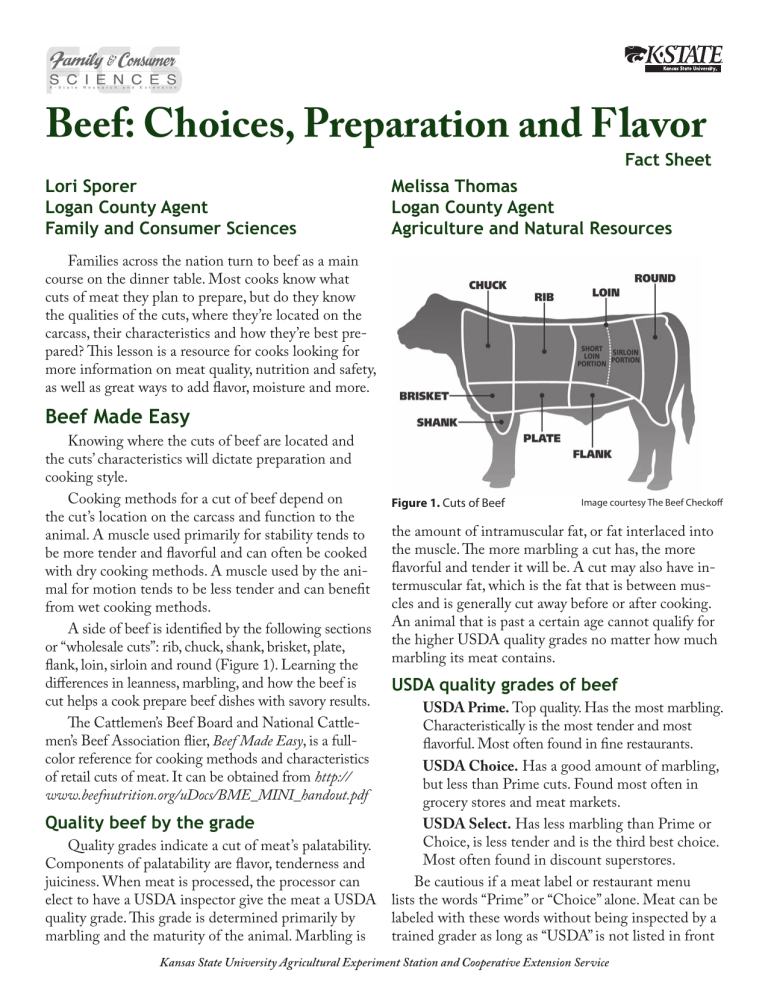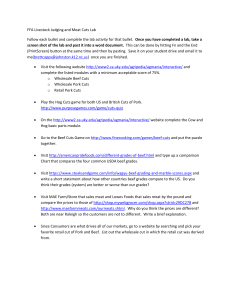Beef: Choices, Preparation and Flavor

Beef: Choices, Preparation and Flavor
Fact Sheet
Lori Sporer
Logan County Agent
Family and Consumer Sciences
Melissa Thomas
Logan County Agent
Agriculture and Natural Resources
Families across the nation turn to beef as a main course on the dinner table. Most cooks know what cuts of meat they plan to prepare, but do they know the qualities of the cuts, where they’re located on the carcass, their characteristics and how they’re best prepared? This lesson is a resource for cooks looking for more information on meat quality, nutrition and safety, as well as great ways to add flavor, moisture and more.
Beef Made Easy
Knowing where the cuts of beef are located and the cuts’ characteristics will dictate preparation and cooking style.
Cooking methods for a cut of beef depend on the cut’s location on the carcass and function to the animal. A muscle used primarily for stability tends to be more tender and flavorful and can often be cooked with dry cooking methods. A muscle used by the animal for motion tends to be less tender and can benefit from wet cooking methods.
A side of beef is identified by the following sections or “wholesale cuts”: rib, chuck, shank, brisket, plate, flank, loin, sirloin and round (Figure 1). Learning the differences in leanness, marbling, and how the beef is cut helps a cook prepare beef dishes with savory results.
The Cattlemen’s Beef Board and National Cattlemen’s Beef Association flier, Beef Made Easy , is a fullcolor reference for cooking methods and characteristics of retail cuts of meat. It can be obtained from http:// www.beefnutrition.org/uDocs/BME_MINI_handout.pdf
Quality beef by the grade
Quality grades indicate a cut of meat’s palatability.
Components of palatability are flavor, tenderness and juiciness. When meat is processed, the processor can elect to have a USDA inspector give the meat a USDA quality grade. This grade is determined primarily by marbling and the maturity of the animal. Marbling is
Figure 1.
Cuts of Beef Image courtesy The Beef Checkoff the amount of intramuscular fat, or fat interlaced into the muscle. The more marbling a cut has, the more flavorful and tender it will be. A cut may also have intermuscular fat, which is the fat that is between muscles and is generally cut away before or after cooking.
An animal that is past a certain age cannot qualify for the higher USDA quality grades no matter how much marbling its meat contains.
USDA quality grades of beef
USDA Prime. Top quality. Has the most marbling.
Characteristically is the most tender and most flavorful. Most often found in fine restaurants.
USDA Choice. Has a good amount of marbling, but less than Prime cuts. Found most often in grocery stores and meat markets.
USDA Select. Has less marbling than Prime or
Choice, is less tender and is the third best choice.
Most often found in discount superstores.
Be cautious if a meat label or restaurant menu lists the words “Prime” or “Choice” alone. Meat can be labeled with these words without being inspected by a trained grader as long as “USDA” is not listed in front
Kansas State University Agricultural Experiment Station and Cooperative Extension Service
of them. These cuts may not actually be USDA Prime or Choice.
Informed choices about cost
Consumers face many challenges in the market when purchasing food for their meals. Stretching their food dollar and stretching a meat dish further is achievable using economical cuts of beef that best suit a meal or preparation method.
The signature of a great steak, roast or other cut of meat is its tenderness, which is beef ’s most important palatability attribute. There are times when consumers are willing to pay for a more expensive cut of meat, for instance at holiday time or for a family celebration when the most “guaranteed tender” cuts are preferred.
The Power of Protein
A vital part of a healthy lifestyle, beef and other lean meat provide essential minerals and protein for strong muscles. The protein in beef and other meats helps build and maintain muscle mass while burning fat. Essential amino acids in protein help muscles support bones and movement.
Protein plays a vital role in weight management and weight loss. A protein-rich diet that combines reduced carbohydrates with exercise improves body composition during weight loss and helps decrease fat because lean muscle mass will increase metabolism.
Muscle burns fat even at rest.
The USDA Dietary Guidelines for Americans recommend that adults eat 5½ ounces of lean protein per day (visit mypyramid.gov
for detailed guidelines based on age and gender). A good way to gauge serving size is to remember that one serving of protein is about the same size as the palm of your hand or a deck of cards.
(For example, a 5-ounce beef strip steak is one serving.)
Vary protein choices by eating lean beef, pork, lamb, poultry, fish, eggs, dairy products, cooked dry beans and peas, nuts and seeds. (Find more information about portion sizes at http://www.mypyramid.gov/
STEPS/howmuchshouldyoueat.html.
)
Shopping Guide
Consider the following when making beef selections:
• Stop at the refrigerated meat case last to ensure that beef stays fresh until you get home.
• Check the “sell-by” date on the label, and purchase only on or before that date. You may store the meat in your refrigerator for up to 3 days or freeze it im-
2 mediately to thaw and cook at a later date.
• Choose packages that are cold and tightly and completely wrapped with no tears or punctures.
• Be sure packages do not contain excess liquid, which can indicate problems with temperature or storage.
• Choose plastic-wrapped beef that is a bright cherry-red color without any gray or brown blotches.
• For vacuum-packaged beef, the seal should not be broken and the package should not leak. Vacuum-packaged beef will change color slightly after opening; it will “bloom” when the seal is broken as oxygen reacts with the meat.
• Choose steaks and roasts that are firm to the touch.
Inexpensive cuts of beef
• Check the “unit price” on the product label, and compare cost per serving, not just price per pound.
• In general, “bone in” meats are less expensive than boneless.
• Buying in bulk will save money. For example, hamburger usually costs less per pound if you buy a 3-pound package rather than a 1-pound package.
• Less expensive, but less tender, steak cuts come from the chuck, round, plate and flank (shoulder steak, eye round steak, top round steak, skirt steak, flank steak).
• Cook once, eat twice. Preparing extra ahead of time is an easy way to create beef dishes that are ready to serve and maximize your food dollar.
Leftover grilled steak can be sliced to accent a salad. Crumble leftover meatloaf or cooked burgers into chili, pizza or pasta dishes. “Planned overs” or extra servings can be frozen for future use in freezer ziplock bags or containers.
•Purchase boneless roasts to cut into steaks. Many butchers will slice them at no extra cost.
•You can freeze uncooked beef for 6 to 12 months.
Preparation tips for low-cost beef
Economical cuts of beef, properly prepared and cooked, can become delicious family favorites.
Braising (slow cooking or pressure cooking) is an ideal way to cook tough and inexpensive cuts of meat. It relies on heat, time, and moisture to successfully break down tough connective tissue in meat. Most braised meats are first seared in a skillet to brown the surface, seal in juices and
enhance flavor. The dish is then simmered, often with a small amount of liquid that may include tomatoes, wine or stock, in a covered pan until the meat is fork tender. The cooking liquid can be used to make a sauce or gravy. The economic benefit is enhanced because a single pot can be used to cook the entire meal.
Stewing is slowly cooking food in its own juices with a small amount of added liquid, resulting in tender meat and a flavored sauce. Foods for stewing are cut into small pieces. Use a dutch oven that has a tight fitting lid to keep evaporation to a minimum. Condensation on the inside of the lid self bastes the food, keeping it moist. The cooking liquid and food are served together in a complete dish. Check the meat throughout cooking, as you may need to add additional liquid.
Stewing works well with cuts such as short ribs, brisket, and rump or bottom round roasts.
Avoid cross contamination
Proper food handling will ensure you bring a safe, wholesome meal to the table each and every time.
Here are some brief reminders concerning safety when handling raw meat.
• Store meat in the refrigerator until you start your meal.
• To thaw frozen beef, set it in a bowl or pan with sides in your refrigerator overnight. For faster thawing, place frozen meat (sealed in plastic) in a large bowl or pan in the sink and fill the pan with cool water. Depending on the size of the meat cut, this method will take 1 to 2 hours. Change the water every 30 minutes to keep meat cold.
You may defrost beef in the microwave, but often with less desirable results.
• Wash hands with hot, soapy water for 20 seconds before, during and after preparation.
• Wash all utensils and surfaces with hot, soapy water after food preparation.
Marinade for Flavor and More
Love the smell of steak on the grill? Beef has highquality taste and flavor. Taste refers to the four basic receptors on taste buds: sweet, salty, sour and bitter.
Flavor is a combination of taste and other sensations such as aroma, texture, juiciness, mouth feel and color.
Marinating beef before grilling, roasting or slow cooking adds depth of flavor and taste.
Balsamic Grilled Steak
Ingredients:
2/3 cup prepared balsamic vinaigrette
¼ cup all-fruit preserves
Salt and freshly ground pepper
1 package (5.2 ounces) herb and garlic soft spreadable cheese
Steaks – beef shoulder top blade steaks (also called flat iron steaks) or boneless thick-cut beef chuck eye steaks
Directions
Prepare the marinade by processing the vinaigrette and fruit preserves in a blender or food processor. Place the steaks in a large resealable plastic bag. Pour marinade over steaks and turn to coat. Seal bag and marinate steaks in the refrigerator for at least 2 hours.
Preheat a grill to medium heat. Remove steaks from marinade; discard marinade. Grill steaks 10 to 14 minutes for medium rare to medium, turning occasionally. Check internal temperature with a meat thermometer (145 degrees for medium rare, 165 degrees for medium). Season with salt and pepper to taste. Allow steaks to rest after removing from the grill to allow juices to redistribute into the meat.
Meanwhile, heat cheese in small saucepan over medium-low heat until melted, stirring frequently, about 2 to 4 minutes.
Serve steaks with cheese sauce.
3
Marinades are seasoned liquid mixes that add moisture, enhance taste and flavor, and tenderize the meat with an acidic ingredient that breaks down the protein structures in the muscle fiber. Breaking down the protein structures also aids digestion.
Acidic ingredients to use in a marinade are:
• Fruit juices: lime, lemon, apple, pineapple, orange, tomato
• Soy sauce
• Wine and wine-based sauces
• Buttermilk or yogurt
• Flavored vinegars: red wine, balsamic, raspberry, apple cider
• Olive oil
Marinades also protect the meat from cancerous compounds that form during grilling. Grilled beef shows high levels of heterocyclic amines (HCAs) – which occur when meat is cooked at 375° or higher – in the black charred residue that results when a grill fire flares up and chars the food. HCAs are linked to cancer.
You can also treat steaks 1 hour before grilling with commercial marinades containing natural antioxidants such as rosemary, thyme, chives, oregano, thyme, and onion to inhibit HCA development.
Food safety reminders
Use a meat thermometer to check for a safe internal temperature, based on the desired degree of doneness. Insert the thermometer into the fullest part of the meat, avoiding the bone.
Medium-rare meats (with a pink center) need to reach an internal temperature of 145 degrees. Medium cooked meats (minimal soft pink center) need to register 160 degrees.
After cooking, allow meat to rest for 10 minutes to allow the meat juices to redistribute into the meat.
Never save and reuse a marinade without reheating it in a saucepan and bringing it to a boil for at least
1 minute.
Easy marinade options
One easy option for a marinade is to use prebottled marinade seasoned and prepared specifically for the meat you’re preparing. If these aren’t available at the grocery store, another easy-to-use marinade is a bottle of vinaigrette salad dressing. The basics are all in one bottle: oil, vinegar and seasonings.
Pour the dressing or marinade into a ziplock bag, add the meat, seal the bag and massage the dressing into the meat to cover. Allow the meat to marinade in the bag – placed inside a bowl or baking dish in case the bag leaks – for at least 1 hour and not more than
24 hours.
Always marinade beef in the refrigerator, never at room temperature.
Resources
Antioxidants May Reduce Heterocyclic Amines in Commercially Marinaded Beef Steaks.
F. Ameri and J. S.
Smith, K-State Research and Extension, Beef Cattle
Research 2007, SRP978.
Vary your Protein, MF2835. Mary Meck Higgins. K-
State Research and Extension, 2008 .
Valuing Beef Tenderness, MF2464. James Mintert, et al.
K-State Research and Extension, 2000.
K-State Research and Extension resources for Human
Nutrition – including Dining on a Dime newsletter,
Family Nutrition Program and other resources – www.ksre.ksu.edu/humannutrition
Fix It Fresh recipe book – www.ksre.ksu.edu/humannutrition/recipebook_pdf
Spend Smart, Eat Smart program,
Iowa State University Extension – www.extension.iastate.edu/foodsavings/meat
USDA Food Guide Pyramid www.mypyramid.gov
Industry Resources
National Cattlemen’s Beef Association www.beef.org
The Cattlemen’s Beef Board www.beefboard.org
Kansas Beef Council www.kansasbeef.org
Reviewers
Karen Blakeslee, extension associate, Rapid Response
Center, K-State Dept. of Animal Science and Industry
Christine McPheter, Director, K-State Research and
Extension-Meade County
Brand names appearing in this publication are for product identification purposes only. No endorsement is intended, nor is criticism implied of similar products not mentioned.
Publications from Kansas State University are available on the World Wide Web at: www.ksre.ksu.edu
Publications are reviewed or revised annually by appropriate faculty to reflect current research and practice. Date shown is that of publication or last revision.
Contents of this publication may be freely reproduced for educational purposes.
All other rights reserved. In each case, credit
Lori Sporer and Melissa Thomas, Beef: Choices, Preparation and Flavor, Fact Sheet ,
Kansas State University, July 2009
Kansas State University Agricultural Experiment Station and Cooperative Extension Service
MF2888 July 2009
K-State Research and Extension is an equal opportunity provider and employer. Issued in furtherance of Cooperative Extension Work, Acts of May 8 and June 30, 1914, as amended. Kansas State University, County Extension Councils, Extension Districts, and United States Department of Agriculture Cooperating, Fred A. Cholick, Director.



